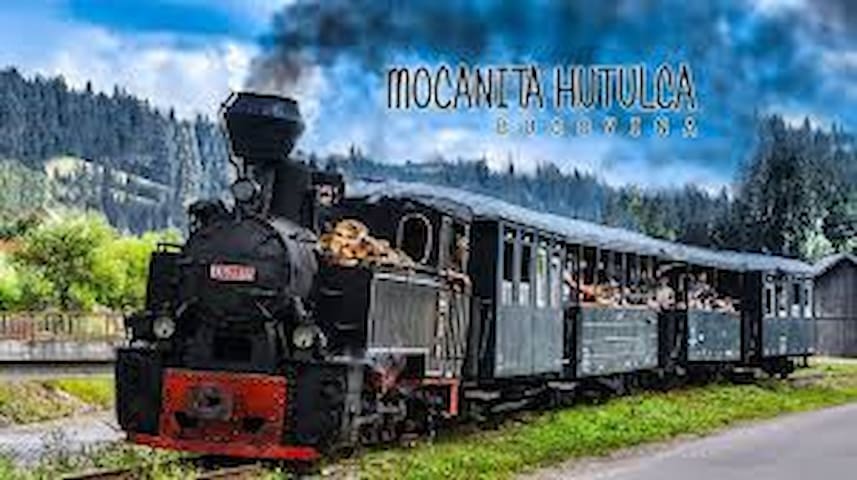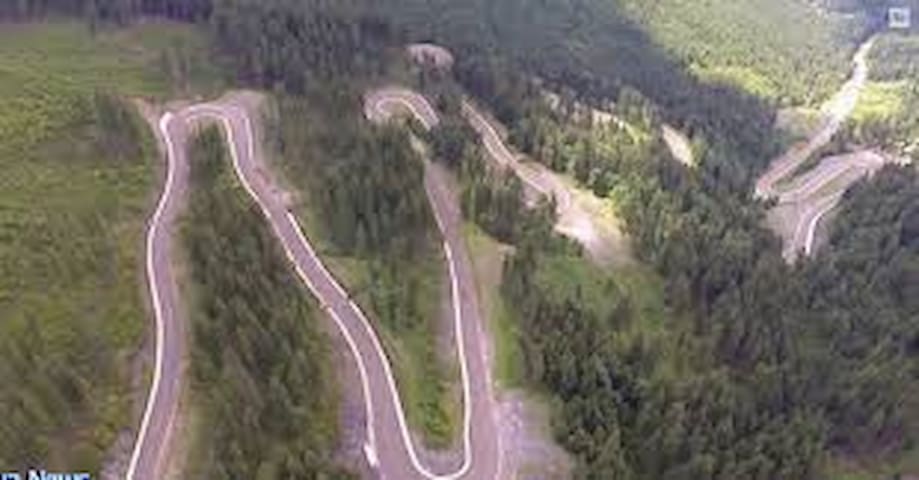Sightseeing
• Deep in the heart of Bukovina, in Vama, we are waiting for you to see the most varied and numerous collection of dyed and decorated eggs in Romania and one of the most important ones in Europe at once. The museum is also helpful to discover the traditions from the area and the art of decorating the Easter eggs. Inside the workshop you can also decorate eggs yourself directed by the teacher Letitia Orsivschi, who is going to explain you the hidden symbols of Bukovina.
The explanations are given in the main international languages (English, German, French). In the museum there are over 7,000 eggs from all over the world displayed in 22 glass-cases
- Muzeul Oului Vama (Vama Egg Museum) – 5 km
Address: Strada Gării nr. 20, Vama 727590
Phone: 0745 869 529
6 Einheimische empfehlen
Eiermuseum Vama
20 Str. Gării• Deep in the heart of Bukovina, in Vama, we are waiting for you to see the most varied and numerous collection of dyed and decorated eggs in Romania and one of the most important ones in Europe at once. The museum is also helpful to discover the traditions from the area and the art of decorating the Easter eggs. Inside the workshop you can also decorate eggs yourself directed by the teacher Letitia Orsivschi, who is going to explain you the hidden symbols of Bukovina.
The explanations are given in the main international languages (English, German, French). In the museum there are over 7,000 eggs from all over the world displayed in 22 glass-cases
- Muzeul Oului Vama (Vama Egg Museum) – 5 km
Address: Strada Gării nr. 20, Vama 727590
Phone: 0745 869 529
• Starting with the summer of 1993 the artist Lucia Condrea opened in Moldovita (Bukovina, Suceava- Romania) a museum that bears her name, unique in Romania and maybe in the world, having in mind the artistical value of the exhibits.
- Muzeul Oului Încondeiat „Lucia Condrea” Moldovița (Moldovita Painted Egg Museum „Lucia Condrea”) – 22 km
Museum der bemalten Eier Lucia Condrea
nr. 87 Strada Stadionului• Starting with the summer of 1993 the artist Lucia Condrea opened in Moldovita (Bukovina, Suceava- Romania) a museum that bears her name, unique in Romania and maybe in the world, having in mind the artistical value of the exhibits.
- Muzeul Oului Încondeiat „Lucia Condrea” Moldovița (Moldovita Painted Egg Museum „Lucia Condrea”) – 22 km
• Muzeul „Arta Lemnului” Câmpulung Moldovenesc („Wood Art” Museum) – 8 km
Address: DN17 31, Câmpulung Moldovenesc 725100
Hours: Opens 9AM
Phone: 0230 311 378
Wood Art Museum
31 DN17• Muzeul „Arta Lemnului” Câmpulung Moldovenesc („Wood Art” Museum) – 8 km
Address: DN17 31, Câmpulung Moldovenesc 725100
Hours: Opens 9AM
Phone: 0230 311 378
• Tucked in the small village of Voroneț, Suceava, you can find what is known at the “Sistine Chapel of the East”: the great Voroneț Monastery.
- Mănăstirea Voroneț (Voroneț Monastery) – 25 km
Address: Strada Voroneț 166, Voroneț, UNESCO Monument
25 Einheimische empfehlen
Voronet-Kloster
166 Strada Voroneț• Tucked in the small village of Voroneț, Suceava, you can find what is known at the “Sistine Chapel of the East”: the great Voroneț Monastery.
- Mănăstirea Voroneț (Voroneț Monastery) – 25 km
Address: Strada Voroneț 166, Voroneț, UNESCO Monument
• It was built in 1585 , the architecture of the church contains both Byzantine and Gothic elements, and some elements typical to other painted churches of northern Moldavia.
- Mănăstirea Sucevița (Sucevița Monastery) – 53 km
Address: DN17A 169, Sucevița, UNESCO Monument
13 Einheimische empfehlen
Sucevita Monastery
169 DN17A• It was built in 1585 , the architecture of the church contains both Byzantine and Gothic elements, and some elements typical to other painted churches of northern Moldavia.
- Mănăstirea Sucevița (Sucevița Monastery) – 53 km
Address: DN17A 169, Sucevița, UNESCO Monument
• Humor Monastery is one of the religious masterpieces of Bucovina, a region best-known for its many churches and monasteries. Part of the UNESCO World Heritage Sites, alongside the painted churches from Voronet, Sucevita or Moldovita, Humor Monastery is almost 500 years old. Its Byzantine frescoes remain, nonetheless, rare and precious until today.
- Mănăstirea Humor (Humor Monastery) – 27 km, UNESCO Monument
7 Einheimische empfehlen
Kloster Humor
DJ177• Humor Monastery is one of the religious masterpieces of Bucovina, a region best-known for its many churches and monasteries. Part of the UNESCO World Heritage Sites, alongside the painted churches from Voronet, Sucevita or Moldovita, Humor Monastery is almost 500 years old. Its Byzantine frescoes remain, nonetheless, rare and precious until today.
- Mănăstirea Humor (Humor Monastery) – 27 km, UNESCO Monument
• The Moldovița Monastery is a Romanian Orthodox monastery situated in the commune of Vatra Moldoviței, Suceava County. The Monastery of Moldovița was built in 1532 by Petru Rareș and it was founded as a protective barrier against the Muslim Ottoman conquerors from the East.
- Mănăstirea Moldovița (Moldovita Monastery) – 20 km, UNESCO Monument
12 Einheimische empfehlen
Kloster Moldovita
• The Moldovița Monastery is a Romanian Orthodox monastery situated in the commune of Vatra Moldoviței, Suceava County. The Monastery of Moldovița was built in 1532 by Petru Rareș and it was founded as a protective barrier against the Muslim Ottoman conquerors from the East.
- Mănăstirea Moldovița (Moldovita Monastery) – 20 km, UNESCO Monument
• The Putna monastery is one of the most important cultural, religious and artistic centers established in medieval Moldavia; it was built by Stephen the Great, famous for building and influencing the building of dozens of churches and monasteries all over Moldavia (allegedly, he founded a religious edifice after each important military victory). The Putna Monastery houses the tombs of Stephen
- Mănăstirea Putna (Putna Monastery) – 59 km
Putna-Klostermuseum
nr. 201 Strada Principală• The Putna monastery is one of the most important cultural, religious and artistic centers established in medieval Moldavia; it was built by Stephen the Great, famous for building and influencing the building of dozens of churches and monasteries all over Moldavia (allegedly, he founded a religious edifice after each important military victory). The Putna Monastery houses the tombs of Stephen
- Mănăstirea Putna (Putna Monastery) – 59 km
The Forestry Narrow Gauge Steam Train
Mocanita (Romanian-“Mocăniţa“) is the Romanian forestry narrow gauge steam train that was born more than 100 years ago. Through mountains and deep forests the train follows the valleys and the river banks to the delight of the tourists.
Therefore mocanita is an invitation for an adventure in the wild Carpathians. An invitation for you to discover or to remember the wild nature landscapes, the fresh forest air and the taste of the forest fruits.
Bahnhof Mocănița Huluboaia, Moldawien
The Forestry Narrow Gauge Steam Train
Mocanita (Romanian-“Mocăniţa“) is the Romanian forestry narrow gauge steam train that was born more than 100 years ago. Through mountains and deep forests the train follows the valleys and the river banks to the delight of the tourists.
Therefore mocanita is an invitation for an adventure in the wild Carpathians. An invitation for you to discover or to remember the wild nature landscapes, the fresh forest air and the taste of the forest fruits.
Hidden between the hills, Cacica is one of the most visited places in Suceava county. The salt-mine has been dug manually under the technical guidance of an Austrian, Paul Hofmann. The giant salt mountain in Cacica can provide enough salt for the entire Europe for the next 400 years!
The name of “Cacica” has its origins in the polish “kaczika”, meaning “duck”, because there used to be many lakes with wild ducks in the region.
The main tourist attractions are:
- the old salt mine, where one can see the roman-catholic chapel “Saint Barbara”, the salt-lake and the ball-room;
- the roman-catholic sanctuary of Cacica;
7 Einheimische empfehlen
Salina Cacica
Hidden between the hills, Cacica is one of the most visited places in Suceava county. The salt-mine has been dug manually under the technical guidance of an Austrian, Paul Hofmann. The giant salt mountain in Cacica can provide enough salt for the entire Europe for the next 400 years!
The name of “Cacica” has its origins in the polish “kaczika”, meaning “duck”, because there used to be many lakes with wild ducks in the region.
The main tourist attractions are:
- the old salt mine, where one can see the roman-catholic chapel “Saint Barbara”, the salt-lake and the ball-room;
- the roman-catholic sanctuary of Cacica;
The Princely Fortress of Suceava built at the end of the 14th century near the Suceava medieval city had been the main residence of Moldavia’s rulers for almost 200 years. Today it is an important national historic monument.
In 2016 in Suceava’s Fortress there was organized the first permanent exhibition which illustrates important themes of great interest for the public, such as the first and the most comprehensive presentation of the medieval weapons in Moldavia, of the heraldic symbols of the Moldavian rulers and aristocrats between the 14th and 17th century or Moldavia’s medieval Treasure. The multimedia systems with medieval historical themes and video projections with subjects about the history of the fortress represent an innovation concerning the exhibition in Romania.
14 Einheimische empfehlen
Festung Suceava
Aleea CetățiiThe Princely Fortress of Suceava built at the end of the 14th century near the Suceava medieval city had been the main residence of Moldavia’s rulers for almost 200 years. Today it is an important national historic monument.
In 2016 in Suceava’s Fortress there was organized the first permanent exhibition which illustrates important themes of great interest for the public, such as the first and the most comprehensive presentation of the medieval weapons in Moldavia, of the heraldic symbols of the Moldavian rulers and aristocrats between the 14th and 17th century or Moldavia’s medieval Treasure. The multimedia systems with medieval historical themes and video projections with subjects about the history of the fortress represent an innovation concerning the exhibition in Romania.
TransRarau ‘The Treasures’ Road’ is said to be the third most beautiful alpine road in Romania. It crosses the Rarau massif and is one of the Romanian high altitude roads.
The road (DJ175B) is 26 km long and links the villages Chiril (on the southern side) and Pojorata (on the northern side) crossing the Rarau Mountains, and climbs up to an elevation of 1.400 m above the sea level. This tourist road facilitates the access to the famous natural monument, ‘Lady’ Rocks’ (Pietrele Doamnei).
Transrarăul
TransrarăulTransRarau ‘The Treasures’ Road’ is said to be the third most beautiful alpine road in Romania. It crosses the Rarau massif and is one of the Romanian high altitude roads.
The road (DJ175B) is 26 km long and links the villages Chiril (on the southern side) and Pojorata (on the northern side) crossing the Rarau Mountains, and climbs up to an elevation of 1.400 m above the sea level. This tourist road facilitates the access to the famous natural monument, ‘Lady’ Rocks’ (Pietrele Doamnei).
hiking and sports
Pârtia Rarău Câmpulung Moldovenesc
km.5 str. Izvorul AlbAirports
Distance - 80 km
Direct flights from: London, Milano, Rome, Bologna, Memmingen, Wien
Flughafen Suceava Ștefan cel Mare
Distance - 80 km
Direct flights from: London, Milano, Rome, Bologna, Memmingen, Wien
Distance - 180 km
Direct flights from: London, Liverpool, Larnaca, Eindhoven, Billund, Wien, Roma, Milano, Catania, Bergamo, Bologna, Munchen, Dortmund, Koln, Bruxelles, Tel Aviv, Paris, București, Timișoara, Cluj
Iasi International Airport
34 Str. Moara de VantDistance - 180 km
Direct flights from: London, Liverpool, Larnaca, Eindhoven, Billund, Wien, Roma, Milano, Catania, Bergamo, Bologna, Munchen, Dortmund, Koln, Bruxelles, Tel Aviv, Paris, București, Timișoara, Cluj


